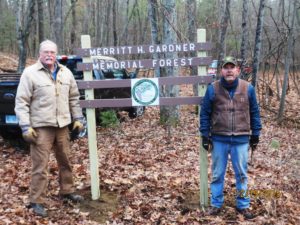The ECFLA & WDLT Mission

The misson of the Eastern Connecticut Forest Landowners Association (ECFLA) & the Wolf Den Land Trust (WDLT) is to:
- Promote wise management of forest lands
- Provide information to help members make informed decisions
- Offer professional forestry assistance to the small forest landowner
- Make forest ownership more attractive as an investment
- Improve communications among landowners, foresters, mill owners, timber harvesters
- Protect open space and professionally manage demonstration forests through the Wolf Den Land Trust.
- Learn more….
MEMBER RESOURCES

Benefits of membership include:
- E-News – Subscribe now for updates on programs, problems in our area, etc.
- Quarterly newsletters filled with practical, informative articles
- Educational meetings and programs
- An annual Forestry Fair
- Equipment to loan: a planting bar and planting shovel for members planting large quantities of forest seedling stock
- Support from natural resource professionals to teach our members about land stewardship
CONSERVING LAND

What the WDLT does and how we help:
- We hold title or conservation easements to woodlands in order to protect them as forest lands and to serve as demonstration woodlands.
- We manage 17 properties totaling more than 882 acres in northeastern Connecticut.
- Many of our managed properties have a trail system and are open to the public for passive recreation.
- Check out the list of properties and view maps
- Contact us today if you are interested in conserving YOUR land!
MOST RECENT POSTS
Some Hope for Your ATV Problems
- By Dennis Hodgin Based on my own experience and conversations with other landowners in Connecticut, the “ATV (All Terrain Vehicle) Problem” is becoming a major issue. ATV’s can be operated legally in Connecticut only on private land and then only with the landowner’s permission. ...
Atlantic White-Cedar
By Dave Schroeder Atlantic white-cedar (Chamaecyparis thyoides), also called white-cedar or swamp cedar, is usually found growing in fairly dense stands in swamps, bogs and, occasionally along streams. Its range is along the Atlantic coast in a belt, 50 to 150 miles wide, from Maine ...
Starting the Land Protection Process: A Few Baby Steps for Forest (and Farm) Owners
- by Steve Broderick As Connecticut’s Extension Forester, it’s been my privilege to meet many hundreds of forest landowners. Over time, many of them have come to love their land, and would love to know it will remain undeveloped after they’re gone. Some landowners feel ...
Sassafras
-by David Schroeder Sassafras (Sassafras albidum) is one of the most easily identified trees in Connecticut. The aromatic leaves are usually Sassafrasone of three distinct shapes: three lobed, mitten shaped (both right and left handed mittens) and unlobed. Twigs are greenish and aromatic and the ...
Invasives. Great Infestations: Connecticut ‘s Response to Green Invaders
- Excerpted from April 2002, CT Council on Environmental Quality The second biggest threat to Connecticut 's natural habitats is invasion by alien plants and animals (behind loss of habitat to sprawling land development.) With few natural enemies, these species grow, spread, and multiply so ...
Connecticut State Lands Habitat Management Program – Part II
- By Paul Rothbart, DEP Wildlife Division Part II Early Successional Stage Vegetation Management The Habitat Management Program manages a diversity of early successional stage habitats comprised of old field, grassland, and agriculture. These habitats are rapidly declining due to natural forest succession, loss ...

